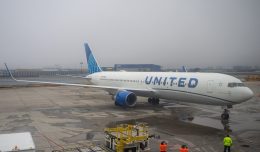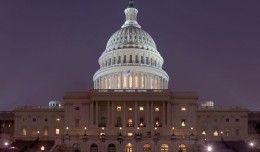Early Friday morning, news started to spread about that the FAA was investigating a “near miss” that occurred between between a Delta 747 and a Shuttle America Embraer E170 on June 13th. According to WABC in New York, one account has the two aircraft coming within 100 feet of each other, quite a dubious claim considering the consequences of such an incident. The Associated Press does not make that same claim in their brief article, but does include comment from the FAA. (That article has since been updated to read “the planes were 200 feet apart verticlaly and about a half mile laterally.” The AP quotes the FAA as saying they aircraft were “turning away from each other at the point where they lost the required separation.”
But what really happened here? While a loss of required separation occurred, what caused it? Here is what we can piece together from the various archives of Flightradar24 and LiveATC.
At approximately 2:15pm on June 13th (The AP report incorrectly states the incident was during the 3pm hour), Delta 172 (the 747) was on final approach to JFK’s runway 4L. At the same time, American 1786, a Boeing 737 was on final approach to runway 4R, just ahead of the Delta 747. At the time, winds were reported to be quite strong, with the METAR reporting wind speeds of 19kt with gusts of up to 28kt. American 1786 declared a go-around, and was given right turn to heading 130 by the JFK tower. American 1786 quickly turned right, and reentered the approach pattern to attempt another landing.
Just seconds later, Delta 172 also declares a go-around. However, because the previous American 737 had just done the same, Delta 172 would not be able to make the usual right turn after a go-around. Departure traffic on JFK’s runway 4L/R typically makes a right turn to avoid conflicting with traffic from LaGuardia, but that was not possible in this unexpected instance where two aircraft went around at the same time.
Delta 172 received a heading of 250 to the left from JFK tower, and climbed to its assigned altitude of 2,000 feet. JFK tower then assigned a right turn to 040 for Delta 172.
Seconds later, JFK tower asks Delta 172 “If able, the best right turn you’re able.” “Ok, we’re turning right, 040” Delta 172 replied. This assigned turn was most likely in anticipation of the conflicting traffic out of LGA, which Delta 172 was headed in the direction of. However, Delta 747s are not the most nimble aircraft in the sky, and they can’t maneuver like an A320. Turns take time for this aircraft.
About 30 seconds later, JFK tower asks Delta 172 “are you turning?” Delta 172 responds “Uh, yes sir, were almost at 040 now.” Immediately after, the JFK tower controller gets back on the radio and states “Delta 172 heavy, traffic 12 o’clock, 1400 feet, Embraer at 1600 feet,” with a tone of importance in his voice. Delta 172 replies “Ok, we got them on the fish finder here,” referring to the traffic collision avoidance system. “Ok, he’s eastbound at 1800 feet climbing out of ZULAV.” At this moment, the two aircraft were at virtually the same altitude, headed for each other. However, all parties involved knew of the conflicting traffic, and both aircraft were actively turning to avoid each other. Delta turning to the right, Shuttle America to the left.
With the TCAS alarm sounding in the background, Delta 172 gets back on the radio and says “OK, we’re turning right to 060.” JFK tower then assigns a heading of 180, and Delta 172 is heading south to re-enter the approach pattern. Just like that, it’s over. Shuttle America 5981 continues on to Jacksonville, and Delta 172 circles back to JFK and lands safely. At all times during this unusual event, all parties involved acted professionally and handled the challenge quite well. It isn’t often JFK could potentially see two go-arounds at virtually the same time, but sometimes the unexpected happens, and you do your best to limit any potential danger, and that is exactly what happened.









